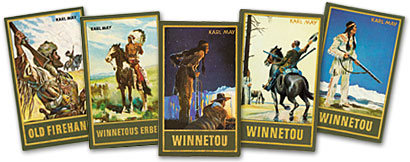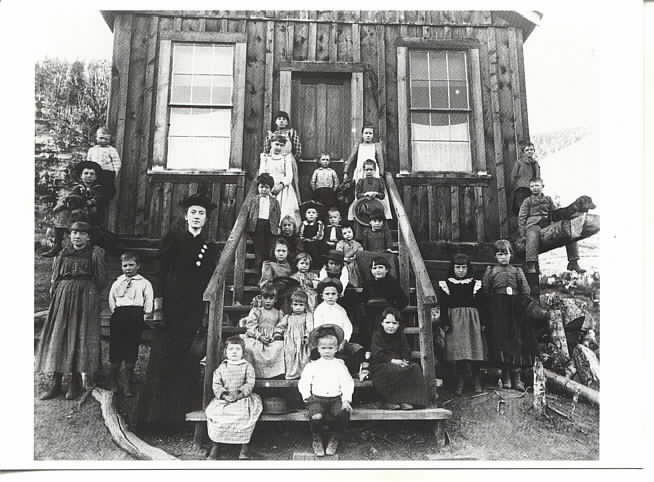|
Irvine Valley College: Online Literature Study of the School of Humanities and Languages Literature 110 - Popular Literature Spring 2013 - Ticket #62740 // Marjorie Coverley Luesebrink, MFA, Instructor
Unit 6c: Cowboy Jamboree Showdown at Yellow Butte, Zane Grey
The Western novel, then, while it seems so particularized with its cowboys and Indians and western locale, actually comes from a deep well of world and American lore. *Riders of the Purple Sage* was not actually the first Western Genre Fiction. That honor is generally accorded to James Fennimore Cooper and his *Leatherstocking Tales* (see above). From the 1850's on, too, western tales of mountain men, outlaws, and frontier derring-do were the subject of very popular "penny dreadfuls" (these are fun to read about - do take the link!) - and even pamphlets that purported to faithfully recreate stories of the west. But probably the first true Western Novel would be Owen Wister's book, *The Virginian.*
"The Virginian" was a novel, a movie, and a popular TV show from Wikipedia - an idea of the plot - Ostensibly a love story, the novel really revolves around a highly mythologized version of the Johnson County War in 1890s Wyoming. The real Johnson County War was a dispute between large ranchers and smaller operators over cattle theft. The novel takes the side of the large ranchers, and depicts the lynchings as frontier justice, meted out by the protagonist, who is a member of a natural aristocracy among men; this theme of the wilderness as a magnifying glass for humans' inherent qualities is also found in other fiction of the period, such as Tarzan of the Apes. In a central episode, the protagonist participates in the lynching of an admitted cattle thief, who had been his close friend. The lynching is represented as a necessary response to the government's corruption and lack of action, but the protagonist feels it to be a horrible duty. He is especially stricken by the bravery with which the thief faces his fate, and the heavy burden it places on his heart forms the emotional core of the story. Structurally, the story is less a novel than an anthology of previously published stories about the central character, with, e.g., the point of view shifting from one chapter to the next. The Virginian, both the character and the book, are considered to be first of their kind. The character is seen as the first real cowboy character that has set the standard for the cowboy character stereotype. The book is seen as one of the first great western novels about cowboys. One thing you will notice here is that we have a first Cowboy - but Wister's famous story centers around land squabbles and cattle rustling. The early novels that actually had a Native American character were written by Karl May - from the Website about him:
Wister, May, Grey, and then Louis L'Amour set the main elements in place for the many popular Western Genre Novels, movies, and TV shows that followed. Generalized Western Icons and their Historical Extent - As mentioned earlier, many commentators postulate that the American Frontier was over by 1890. By the same token, different thematic elements of the genre have been glossed over in some modern interpretations, but they generally have a fixed period of possibility. Cowboys: lots of men wore six-guns and spurs in the Old West, but the actual cattle drives - and thus the real cowboys - were limited in time. Each spring from 1866 - 1885, Texas longhorns were driven to railheads in Kansas or farther north to stock the open ranges. It took about a dozen cowboys to trail 2,000 head of cattle. Herd size ranged from around 1,000 head in the early years to 3,000 - 4,000 later on. For their labors, cowboys earned between $25 and $40 a month, plus their food. (See Cattle Drives in the Old West!) Later, cattle were transferred by rail car.
Historic image of Round-up scenes on Belle Fouche
[sic] in 1887. It was taken in 1887 by Grabill, John C. H., photographer.
The image shows Cowboys and cattle on range on a Cattle Drive. "Indians" - While the westward-moving hunters, trappers, and settlers were always intruders on Native American land, the "heroes" of the west were notably pro-Indian. In most frontier and western stories, the wilderness leader often knew the tribes well, had many friends within them, often had lived in tribal villages for a time, and credited his skills to native knowledge. Many fictional stories (and real ones) have the Hero accompanied by a Native American sidekick. And, despite the persistent myth of cowboys fighting "Indians" - there is very little historical overlap between real cattle drives and real Native American tribal activity. By 1866 most of the tribal integrity of the Native Americans had been destroyed, and these tribes were no longer able to mount and sustain long-term warfare. The Battle of Little Big Horn, for example, took place in 1876; while Custer lost, of course, the US was on the winning end at the end of a long, long war. While the Battle of Wounded Knee did not take place until 1890 - it represented a disgraceful last massacre, not a battle. "The Schoolteacher" - Western novels, movies, and TV shows have featured the frontier school teacher. Usually she doesn't figure in "captivity" scenarios - although she, and her sister, the lone female land owner - are often terrorized or victimized. [The female land-owner usually has inherited this ranch from her father - whose death or disappearance is often related to the activities of the designated "outlaws." Our model in *Showdown* is, of course, Constance (Connie) Duane. She isn't s schoolteacher, but she is first seen reading a book, wearing a gray skirt and white blouse, and "having money of her own" - so she fits the bill quite well!] The picture of the "Woman in the West" is a conflicted one. We recognize it, but we have a hard time sorting it out. On the one hand, this damsel is certainly portrayed as brave and spunky enough to be out in the wilderness - but at the critical moment, she can also be found looking for a man to assist her (with his guns). It is also instructive to note that, up until 1930, more than 80% of US school districts did not employ Married women [thus, the appropriate erotic overtones]. If a single woman were to be get married, she would have to leave her position. [see more Women Landowners in next section on "Showdown"]
Frontier School House In general, the "Schoolteacher" is part of a more settled community that has, at least, the organization and wherewithal to build a schoolhouse and pay a teacher; these one-room-schoolhouses would usually occur much later than the historical presence of Native Americans. The Sidekick: Many Western Heroes had sidekicks who rode with them and "watched their back." A good idea. "Showdown at Yellow Butte" has most of these elements - but rendered in slightly different form. Let us take a look! Continue to next page - to Unit 6d More about *Showdown at Yellow Butte*
Western: Louis L'Amour. Here is his bio page: http://www.louislamour.com/aboutlouis/biography.htm. The page includes links to lists of titles.
Marjorie Coverley Luesebrink: write to me with questions!
Marjorie Coverley Luesebrink, MFA, your Instructor, is a Professor of English in the School of Humanities and Languages, Irvine Valley College, Irvine, California. See Online writing at Home Page. |
|
| MENUBAR: About Your Class // Class Syllabus // Lecture Notes // Reading List // Recommended Reading // Assignments // Grading Policies // Contact Your Instructor // Announcements // Discussion |





